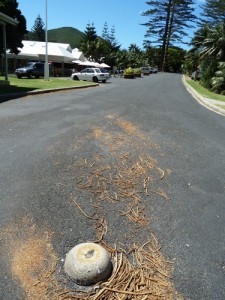 Since this blog has become something of a travelogue, I should write about Lord Howe Island, which I visited recently although it is not an ideal destination for someone hoping to study pavements and pavement graffiti.
Since this blog has become something of a travelogue, I should write about Lord Howe Island, which I visited recently although it is not an ideal destination for someone hoping to study pavements and pavement graffiti.
A few facts and figures then. Lord Howe is a World Heritage island paradise located some 600 km east of the Australian mainland. Nearly all the roads on the island are sealed but there are only 10 km of them. There are very few kerbs, gutters or paved footpaths. The speed limit for the 100 or so motorized vehicles on the island is 25 km per hour, consequently there are hardly any street signs except for one or two Stop signs and several warning about Mutton Birds on Road and Woodhens on Road.
I kept an eye out for graffiti and traffic marks on the bitumen itself but found none. Well, almost none, except for one upside-down-pudding-bowl ‘silent cop’ (correct terminology: traffic dome) at the
T-intersection of Lagoon Road and Ned’s Beach Road, and some
angle-parking spaces marked out nearby.
 The only other pavement embellishment I found was an exceedingly flat rat on the road outside the Museum (close-up view omitted in deference to the squeamish). Rats came to the island off the wrecked ship Makambo in 1918 and promptly set about making at least five native bird species extinct. Rat control measures have been in place since then. Although not totally successful, these measures are probably more efficient and certainly less random than squashing by car.
The only other pavement embellishment I found was an exceedingly flat rat on the road outside the Museum (close-up view omitted in deference to the squeamish). Rats came to the island off the wrecked ship Makambo in 1918 and promptly set about making at least five native bird species extinct. Rat control measures have been in place since then. Although not totally successful, these measures are probably more efficient and certainly less random than squashing by car.